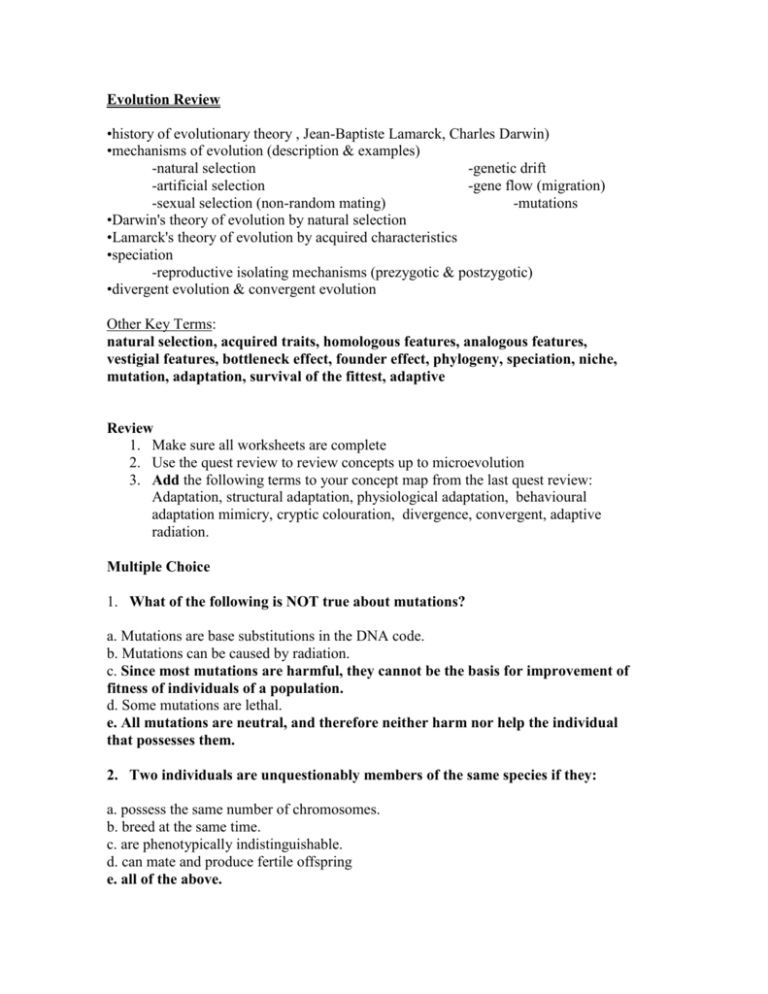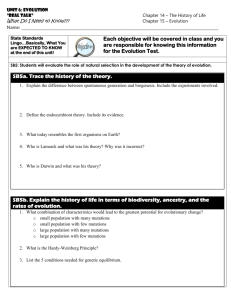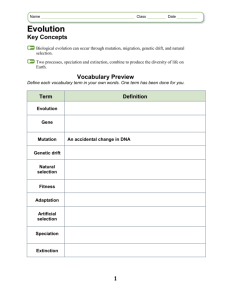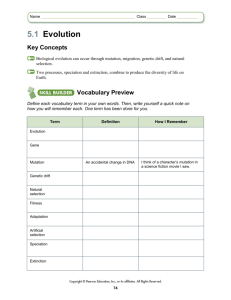Evolution Review: Concepts, Mechanisms, and Speciation
advertisement

Evolution Review •history of evolutionary theory , Jean-Baptiste Lamarck, Charles Darwin) •mechanisms of evolution (description & examples) -natural selection -genetic drift -artificial selection -gene flow (migration) -sexual selection (non-random mating) -mutations •Darwin's theory of evolution by natural selection •Lamarck's theory of evolution by acquired characteristics •speciation -reproductive isolating mechanisms (prezygotic & postzygotic) •divergent evolution & convergent evolution Other Key Terms: natural selection, acquired traits, homologous features, analogous features, vestigial features, bottleneck effect, founder effect, phylogeny, speciation, niche, mutation, adaptation, survival of the fittest, adaptive Review 1. Make sure all worksheets are complete 2. Use the quest review to review concepts up to microevolution 3. Add the following terms to your concept map from the last quest review: Adaptation, structural adaptation, physiological adaptation, behavioural adaptation mimicry, cryptic colouration, divergence, convergent, adaptive radiation. Multiple Choice 1. What of the following is NOT true about mutations? a. Mutations are base substitutions in the DNA code. b. Mutations can be caused by radiation. c. Since most mutations are harmful, they cannot be the basis for improvement of fitness of individuals of a population. d. Some mutations are lethal. e. All mutations are neutral, and therefore neither harm nor help the individual that possesses them. 2. Two individuals are unquestionably members of the same species if they: a. possess the same number of chromosomes. b. breed at the same time. c. are phenotypically indistinguishable. d. can mate and produce fertile offspring e. all of the above. 3. New combinations of genes may be produced by: a. hybridization b. mutation c. crossing over d. sexual reproduction e. all of the above 4. The theory of natural selection postulates that: a. in each generation, individuals well adapted for their environment are more likely to live longer and tend to produce more progeny than the less well adapted individuals b. the death of individuals occur completely at random with respect to their genotypes c. the death of individuals occur completely at random with respect to their phenotypes d. the survival and reproductive success of individuals depend to a limited extent upon their genetic adaptations to their environment e. most deaths of individual organisms occur soon after fertilization, as a result of hereditary deficiencies 5. Four of the five answers listed below are characteristic of mutations Select the exception a. predictable b. b. lethal, beneficial or neutral c. random d. effects depend upon environment e. heritable 6. The number of different alleles per gene in a natural population is most frequently: a. one b. two c. many more than two d. greater than two, but never greater than ten e. none of the above 7. Gene flow is best defined as: a. the movement of genetic material from the nucleus to the cytoplasm b. the transmission of genetic information from the cytoplasm to the nucleus c. the transmission of genetic information from the parents to the offspring d. the change in alleles through a population over a period of successive generations e. the movement of genes from one chromosomes to another 8. Natural selection can best be defined as: a. the best-adapted individuals live to a very old age b. differential reproduction c. differential population-growth rates d. enhanced survival of those individuals with favorable acquired phenotypic traits e. the elimination of the weak by the strong 9. Which of the following is NOT correct with respect to natural selection and adaptation? a. In a few generations, a population being subjected to natural selection should reach adaptive perfection b. Since predators also evolve, their prey can never evolve perfect adaptations c. The process of natural selection tends to remove the less fit, but sometimes even the least fit will survive and produce offspring d. Natural selection acts on prey but never predators. e. Two of the above choices are correct 10. The influence of genetic drift on allele frequencies increases as: a. gene flow increases. b. population size decreases. c. mutation rate decreases. d. the number of heterozygous loci increases. e. all of the above. 11. The primary evolutionary unit is the: a. individual b. population c. germ cell d. gene e. cell Short Answer 12. Differentiate between the terms “evolution” and “natural selection.” Evolution: “change in allele frequency” for inherited characteristics over successive generations (aka change in genetic composition) Natural Selection: individuals of a population with a certain characteristic that helps survival are more likely to pass on their genes to the next generation. 13. Name, describe three mechanisms of microevolution other than natural selection. Be sure to give an example as part of the description. Bottleneck, Founder effect, Mutation and/or Non-random Mating 14. These pictures show the wing structure of a bird and a butterfly. Are these analogous, homologous or vestigial structures? Explain. [2] Analogous. Clearly, these species are of a different evolutionary chain (bird/avian species vs insect) Both however, have a body part or structure that serves the same purpose: flight. 15. Explain the two different types of reproductive isolating mechanisms. Include an example of each in your explanation. Pre-zygotic - ______________________ Post-zygotic - _____________________ 16. Describe the process of sympatic speciation. Occurs without a physical barrier between members of a population that is changing/evolving. Some members exhibit a different behaviour in living, reproductive choice, etc that naturally prevents members from breeding with some others of the same species. These 2 “groups” continue to live without any gene flow between the 2 groups. As such, they may begin to diverge until allele frequencies change and result in speciation. 17. An examination of the fossil evidence indicates that, over time, giraffes have become taller, with longer legs and necks. a. Explain this evidence using the Theory of Evolution by Acquired Characteristics. b. Explain this evidence using the Theory of Evolution by Natural Selection. a) A giraffe obtained/developed a neck longer than its peers during its lifetime and passed this on, as is, to its offspring. This occurs in succession, as latter generations continue to inherit the progressively longer neck of its parent e.g. if one parent has a short neck, all daughter-generation babies will have short necks, fully inheriting the traits of the previous generation, regardless of whether it provides better survival and probability of reproduction b) Within a large population, with a variety of neck lengths, those with longer necks had an advantage over shorter necks for survival. Over a long period of time, those with longer necks had higher probability of survival to pass on its genes to the next generation. 18. Identify and describe the pattern of speciation that is shown in each diagram. A = Anagenesis (not learned) aka transformation B = Cladogenesis (not learned) aka divergent evolution (briefly discussed as a form of speciation) 19. Define and provide an example of each of the following: Stabilizing selection – outliers/extreme mutation types or those furthest from the population’s “norm” are less successful in reproducing. The “majority” is selected by nature. It does not shift the population curve. e.g insects that only mate if you are of “medium” size Disruptive selection – The “majority” is affected by an environmental pressure. Those with extreme mutations by chance have a higher probability to reproduce/survive. The bellcurve is split down the middle into 2 smaller populations, with the 2 ends of the spectrum now becoming the majorities. e.g. black insects hide well in soil, white insects hide well in snow. Brown insects are suddenly easily seen by a new species of birds that entered the ecosystem. Directional selection – One side of extreme mutation or variation cannot survive due to a new environmental pressure, while the other extreme variation gains an advantage. As this advantageous extreme variation has a higher probability of passing its genes to the next generation, the “majority” begins to acquire the successful mutation, shifting the bell curve. e.g. One day, giraffes suddenly find males with the longest necks very charming.









